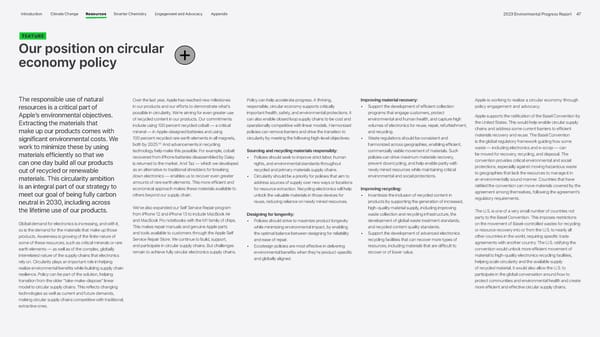Introduction Climate Change Resources Smarter Chemistry Engagement and Advocacy Appendix 2023 Environmental Progress Report 47 Feature Our position on circular economy policy The responsible use of natural Over the last year, Apple has reached new milestones Policy can help accelerate progress. A thriving, Improving material recovery: Apple is working to realize a circular economy through resources is a critical part of in our products and our efforts to demonstrate what’s responsible, circular economy supports critically • Support the development of efficient collection policy engagement and advocacy. Apple’s environmental objectives. possible in circularity. We’re aiming for even greater use important health, safety, and environmental protections. It programs that engage customers, protect Apple supports the ratification of the Basel Convention by Extracting the materials that of recycled content in our products. Our commitments can also enable closed loop supply chains to be cost and environmental and human health, and capture high the United States. This would help enable circular supply include using 100 percent recycled cobalt — a critical operationally competitive with linear models. Harmonized volumes of electronics for reuse, repair, refurbishment, chains and address some current barriers to efficient make up our products comes with mineral — in Apple-designed batteries and using policies can remove barriers and drive the transition to and recycling. materials recovery and reuse. The Basel Convention significant environmental costs. We 100 percent recycled rare earth elements in all magnets, circularity by meeting the following high-level objectives: • Waste regulations should be consistent and is the global regulatory framework guiding how some work to minimize these by using both by 2025. 60 And advancements in recycling harmonized across geographies, enabling efficient, technology help make this possible. For example, cobalt Sourcing and recycling materials responsibly: commercially viable movement of materials. Such waste — including electronics and e-scrap — can materials efficiently so that we recovered from iPhone batteries disassembled by Daisy • Policies should seek to improve strict labor, human policies can drive maximum materials recovery, be moved for recovery, recycling, and disposal. The can one day build all our products is returned to the market. And Taz — which we developed rights, and environmental standards throughout prevent downcycling, and help enable parity with convention provides critical environmental and social out of recycled or renewable as an alternative to traditional shredders for breaking recycled and primary materials supply chains. newly mined resources while maintaining critical protections, especially against moving hazardous waste down electronics — enables us to recover even greater • Circularity should be a priority for policies that aim to environmental and social protections. to geographies that lack the resources to manage it in materials. This circularity ambition amounts of rare earth elements. This more efficient and address sources of supply over new ways or locations an environmentally sound manner. Countries that have is an integral part of our strategy to economical approach makes these materials available to for resource extraction. Recycling electronics will help Improving recycling: ratified the convention can move materials covered by the meet our goal of being fully carbon others beyond our supply chain. unlock the valuable materials in those devices for • Incentivize the inclusion of recycled content in agreement among themselves, following the agreement’s neutral in 2030, including across reuse, reducing reliance on newly mined resources. products by supporting the generation of increased, regulatory requirements. the lifetime use of our products. We’ve also expanded our Self Service Repair program high-quality material supply, including improving The U.S. is one of a very small number of countries not from iPhone 12 and iPhone 13 to include MacBook Air Designing for longevity: waste collection and recycling infrastructure, the party to the Basel Convention. This imposes restrictions Global demand for electronics is increasing, and with it, and MacBook Pro notebooks with the M1 family of chips. • Policies should strive to maximize product longevity development of global waste treatment standards, on the movement of Basel-controlled wastes for recycling so is the demand for the materials that make up those This makes repair manuals and genuine Apple parts while minimizing environmental impact, by enabling and recycled content quality standards. or resource recovery into or from the U.S. to nearly all products. Awareness is growing of the finite nature of and tools available to customers through the Apple Self the optimal balance between designing for reliability • Support the development of advanced electronics other countries in the world, requiring specific trade some of these resources, such as critical minerals or rare Service Repair Store. We continue to build, support, and ease of repair. recycling facilities that can recover more types of agreements with another country. The U.S. ratifying the earth elements — as well as of the complex, globally and participate in circular supply chains. But challenges • Ecodesign policies are most effective in delivering resources, including materials that are difficult to convention would unlock more efficient movement of interrelated nature of the supply chains that electronics remain to achieve fully circular electronics supply chains. environmental benefits when they’re product-specific recover or of lower value. material to high-quality electronics recycling facilities, rely on. Circularity plays an important role in helping and globally aligned. helping scale circularity and the available supply realize environmental benefits while building supply chain of recycled material. It would also allow the U.S. to resilience. Policy can be part of the solution, helping participate in the global conversation around how to transition from the older “take-make-dispose” linear protect communities and environmental health and create model to circular supply chains. This reflects changing more efficient and effective circular supply chains. technologies as well as current and future demands, making circular supply chains competitive with traditional, extractive ones.
 Apple Environmental | Immersive Page 46 Page 48
Apple Environmental | Immersive Page 46 Page 48